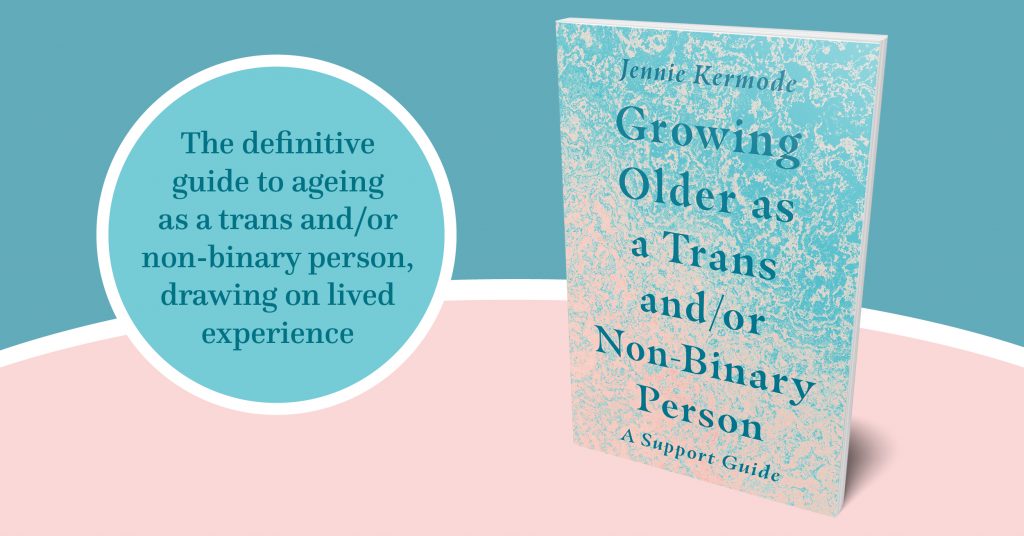
Jennie Kermode, author, journalist and secretary of Trans Media Watch, explores how shifting attitudes towards gender have affected older trans and/or non-binary people, and why it’s vital that we make room for the older generation in current trans spaces and narratives.
LGBT History Month brings with it a lot of focus on events – especially those involving key decisions taken outside our community but with dramatic effects on our lives. This isn’t the only way of looking at history, however, and equally important is reflecting on the way that our own perspectives have changed. This came to the fore for me when writing my latest book, Growing Older as a Trans and/or Non-Binary Person, which comes out this month. In looking at the challenges faced by people in these groups in later life, I found again and again that concerns were expressed over the gap between how many older people understand themselves and the modern understanding of gender which support workers and members of the wider LGBTQ+ community expect them to fit into.
A century ago, there were to ways in which the general public conceptualised trans people. The first was as a variation on gay people, an idea which still has its adherents today and has been obliquely revived by anti-trans campaigners suggesting that some people transition in order to be straight (completely failing to grasp how prevalent transphobia is even in places where gay people are accepted). The second was as people with an unusual birth defect which could be corrected by surgery, making them just like anybody else and preserving them from a socially unacceptable state of gender ambiguity.
Four decades later, these attitudes had begun to harden into the notion that there were two types of trans woman. Those who were attracted to men were seen as similar to gay men and met with the same type of social approbation. Those who were attracted to women received more sympathetic treatment, and it was around their situation that advocacy for trans rights began. The idea that anyone was attracted to both men and women was pretty much written off by mainstream society. Trans men were not taken seriously or were thought of as an extreme form of lesbian (regardless of their sexual orientation). Some found a home within the lesbian community where they were able to express their masculinity, but in wider society they were treated with pity or scorn or just not taken seriously. Non-binary people were seen as deliberately provocative, or not seen at all.
This history will be familiar to many, but what gets overlooked is the fact that it’s not just academic to older trans people. They grew up in that world and their identities were shaped by it. When mainstream society fails to provide answers, we understand ourselves as best we can based on the available information and the prevailing ideas around us. A lot of us come up with creative ways of doing this in childhood, explaining to ourselves why we weren’t like other kids or weren’t the way that adults expected us to be. We then gradually disposed of or revised those notions as we became aware of other trans people and the options we might have in life. Many members of the older generation were in their thirties or forties before they had any contact with positive ideas about being trans, and it gets harder to revise fundamental ideas about one’s own identity as one gets older.
The upshot of this is that older people often find it hard to relate to present day ideas of what it means to be a trans man or a trans woman, or to have some form of non-binary identity, even if others think it obvious that they belong in one of these groups. They might use language that younger people consider inappropriate, or they might become frustrated when attempts to connect with the wider trans community leave them feeling that they and their ideas are unwelcome – on top of the more general challenges posed by trying to connect, as an older person, with a social scene which tends to focus heavily on youth.
It may sometimes be uncomfortable for younger people, but part of making our community inclusive and truly representative involves making room for these people. It doesn’t mean tolerating behaviour which causes distress – this isn’t like being asked to put up with your racist uncle for the sake of a quiet family Christmas – but it does mean accepting people’s diverse conceptions of themselves and of what being trans or non-binary means to them. They may have spent most of their lives without support and finding it in later life can mean that they finally have the opportunity to bloom. At times when elements in wider society seem set on crushing us, they can teach us all of a few things about resilience, and can remind us how much we still have to be grateful for.
Rather than trying to revise the past, we can learn from what older trans people have carried with them into the present day. Our history is living, and we owe it to these people to keep listening to their voices for as long as we can. After all, we are only able to enjoy the freedoms that we do today because of what they built.
Follow Jennie Kermode on Twitter here.
Join our mailing list for more exclusive content like this from our authors.